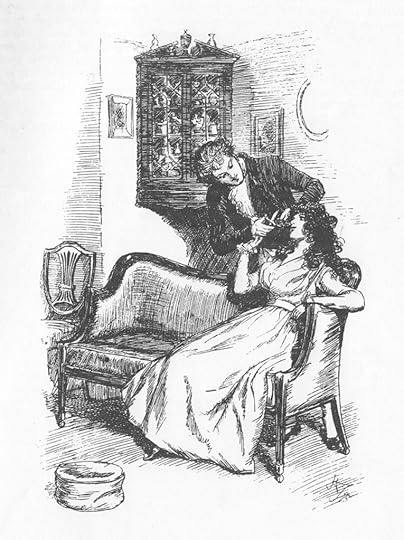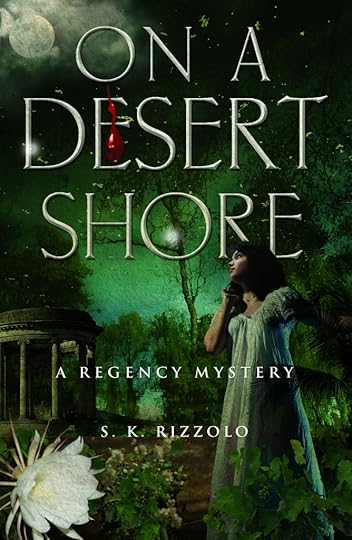Mysteries of the Human Heart in Austen’s Sense and Sensibility, by S.K. Rizzolo
According to Ellen R. Belton, “the pattern of mystery is a vitalizing structural principle in all of Austen’s novels” (“Mystery Without Murder: The Detective Plots of Jane Austen” [Nineteenth-Century Literature 43.1 [1988]). Sense and Sensibility fits this pattern as Elinor Dashwood acts as a kind of detective, striving to penetrate the secrets that threaten her own happiness and that of her beloved sister Marianne. Secrets, in fact, are the lifeblood of mystery stories—and any secret possesses a dangerously unpredictable power. To protect herself, Elinor remains guarded until it’s safe to show her vulnerability. In the meantime, she uses her “sensing” apparatus—that is, her rational intelligence and keen powers of observation, paired with earnest efforts to restrain her impulses—to steer a course through murky, shark-infested social waters.

(From Sarah: This is the fifth guest post in “A Summer Party for Sense and Sensibility,” which began on June 20th and will continue through to the end of the summer. You can find all the contributions to the blog series here . I hope you’ll join the conversations about S&S in the comments here and on social media: #senseandsensibilitysummer. Thanks for celebrating Jane Austen’s first published novel with us!)
Let there be no mistake—the consequences of failure are very real. Austen may not give us a dead body on the library carpet—but, as shown by the fate of the two Elizas (one is Colonel Brandon’s tragic first love; the other, her daughter seduced by Willoughby), any woman who fatally misreads a lover’s character can expect disgrace and suffering. Marianne, who scorns to hide her feelings, pays a high price for bestowing her affection on the charismatic Willoughby too soon. Indeed, she nearly dies of grief. Elinor, more cautious, humbly acknowledges the risk of error in herself and others: “I have frequently detected myself in such kind of mistakes . . . in a total misapprehension of character in some point or other. . . . Sometimes one is guided by what [people] say of themselves, and very frequently by what other people say of them, without giving oneself time to deliberate and judge” (Volume 1, Chapter 17). As a result, she waits until the mysteries surrounding her lover, Edward Ferrars, are exposed before she confesses her love.
Of course, no mystery novel is complete without the clues, which theoretically point to an objective truth. In a mystery novel, this might be a bloodstained glove, a handkerchief dropped at a murder scene, or a discrepancy in an alibi. Austen does something similar in her novel as Elinor struggles to read the tangible signs she encounters in order to gain a better understanding of the people around her. Though not infallible, she is usually more right than wrong, probably because she waits to commit herself until she has more information. The clues are important, but in Austen, they tend to evoke complicated assessments of human nature, rather than pat solutions.

Let’s look at two of these clues—the dual locks of hair or love tokens. The first belongs to Marianne, and its origin is clear because Elinor’s younger sister Margaret witnesses the moment when Marianne gives it to Willoughby. Later this lock of hair seems to be proof positive of Willoughby’s unmitigated villainy when he encloses it in the insolent letter sent to Marianne ending their relationship. But, as it turns out, this clue is not so straightforward, as Elinor herself realizes when a distracted Willoughby shows up to confess his love for the gravely ill Marianne. The cruelty expressed in the letter was not Willoughby’s, after all. Every word of it, as well as the decision to return the lock of hair, comes from Willoughby’s jealous fiancée. None of which excuses Willoughby, as Elinor comments to her sister: “The whole of his behaviour . . . from the beginning to the end of the affair, has been grounded on selfishness” (Volume 3, Chapter 11). Intentional cruelty toward a woman he had genuine feelings for? No. Pursuit of his own pleasures and mercenary interests at Marianne’s expense? Yes.

Willoughby cuts off a lock of Marianne’s hair while she gazes at him adoringly. Illustration by Hugh Thomson (1860-1920).
What about the second love token? Elinor spots a lock of dark hair in a ring worn by Edward Ferrars and immediately feels “satisfied” the hair is her own (Volume 1, Chapter 18). And on what slender grounds! (For one thing, it’s hard to imagine the staid Edward creeping up behind Elinor with the scissors. . . .) But the hair is the same shade as hers, and she is convinced that despite his reticence, Edward reciprocates her feelings. Jumping to conclusions is an unusual lapse for Elinor, a kind of wishful thinking she usually avoids, and I think it stems from the strength of her regard for him. However, when presented with irrefutable proof she’s made a mistake, Elinor doesn’t shrink from reality. The hair is Lucy Steele’s and is concrete evidence of the engagement between her and Edward. Even then Elinor keeps her composure and resigns herself to losing her lover, although she experiences “an emotion and distress beyond any thing she had ever felt before” (Volume 1, Chapter 22). Still, this clue isn’t very straightforward either. It doesn’t prove Edward’s love for Lucy. Instead it’s indicative of his youthful folly in entangling himself in an unwise engagement and then being too honorable to abandon his promise. Elinor ultimately reaches a solid understanding of his character—with Austen’s wry commentary infused in the narrative voice: “His heart was now open to Elinor, all its weaknesses, all its errors confessed, and his first boyish attachment to Lucy treated with all the philosophic dignity of twenty-four” (Volume 3, Chapter 13). Edward, though flawed like the rest of us, can finally take his rightful place as her partner.
My favorite clue—or perhaps it’s better referred to as a red herring—is Colonel Brandon’s flannel waistcoat. No lover worth his salt would ever wear such a garment, and it suggests that Brandon, all of thirty-five, is an ailing dotard with one foot in the grave. Thus, in Marianne’s eyes, he can never become a figure of romance. Once again, looks are deceptive. Brandon is pure, steady, upright—he embodies a veritable catalog of virtues. And he harbors a poetic soul, falling in love with Marianne at first sight and nobly dedicating himself to her service. Austen has fun joking about the dashing of Marianne’s absurd romantic pretentions but also gives her the requisite happy ending: “Marianne could never love by halves; and her whole heart became, in time, as much devoted to her husband, as it had once been to Willoughby” (Volume 3, Chapter 14).
By the end of the novel, the secrets have been dispelled, and the hearts of the characters are open to each other. But in Austen’s scheme that doesn’t mean that all the wicked people are cast into hell, while the virtuous are elevated to an implausible sainthood (even Willoughby goes on to enjoy a reasonably contented life.) Austen is after something richer and more complicated than a simple moral equation. As Elinor and Marianne’s cold, greedy brother says in a moment of unintended irony: “Well, I am convinced that there is a vast deal of inconsistency in almost every human character” (Volume 3, Chapter 5). Very true—but Elinor’s patient observation has been amply rewarded. In the fullness of time and with her admirable sleuthing skills, she has arrived at a just estimation of the truth.
Quotations are from the Penguin Classics edition of Sense and Sensibility, edited with an introduction and notes by Ros Ballaster (2014).

S.K. Rizzolo earned an M.A. in literature before becoming a high school English teacher and author. A lifelong Anglophile and history enthusiast, she loves writing about the lives of women. Rizzolo got the writing bug when her only child was a little girl and went on to publish four Regency mysteries with the highly regarded Poisoned Pen Press. Her mysteries feature an unconventional lady, a Bow Street Runner, and a melancholic barrister. Rizzolo will soon launch a new Victorian series introducing a “redundant” spinster striving to become a young Miss Marple. The flower photos are from her garden in the San Fernando Valley in Southern California. https://skrizzolo.com/

If you enjoyed this post, I hope you’ll consider recommending it to a friend. If you aren’t yet a subscriber, please sign up to receive future guest posts in “A Summer Party for Sense and Sensibility.” The next post, “Secrets and Silence in Sense and Sensibility,” is by Deb Barnum.
Here are the links to the last two posts, in case you missed them:
The Darkness of Sense and Sensibility, by Deborah Yaffe
Sense and Sensibility in my most need, by Heidi LM Jacobs

Read more about my books, including Jane Austen’s Philosophy of the Virtues and Jane Austen and the North Atlantic, here.



